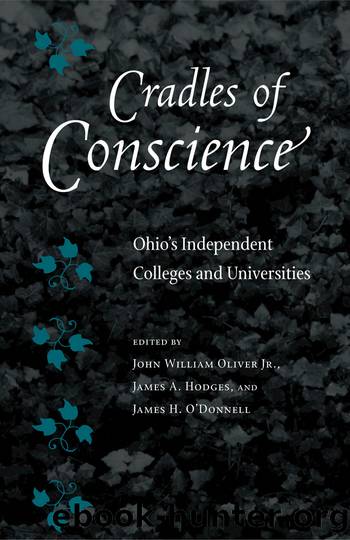Cradles of Conscience by Oliver Jr. John William;Hodges James A;O'Donnell James H.;

Author:Oliver Jr., John William;Hodges, James A;O'Donnell, James H.;
Language: eng
Format: epub
Publisher: The Kent State University Press
SUGGESTED READING
Helpful in the research for this essay were the publications by the Sisters of Charity: Judith Metz, Women of Faith and Service: The Sisters of Charity of Cincinnati (1997), and Benedicta Mahoney, We Are Many . . . : A History of the Sisters of Charity of Cincinnati 1898â1971 (1982).
Mount Union College
The Experiences of âIntegral Educationâ
JOHN SAFFELL
In the autumn of 1846 a young man of twenty-three who had just completed his freshman year at Allegheny College came to the little village of Mount Union (now part of Alliance, Ohio) to help care for a sister who was dying of âpulmonary consumption.â That man was Orville Nelson Hartshorn, now remembered as the founder and first president of Mount Union College. While he was on this mission of mercy, a few youths of the small community asked the young undergraduate to establish a subscription school. It opened with six students on October 20, 1846, in the third-floor attic of a woolen mill. These were the humble beginnings of Mount Union College.
A couple of weeks before this opening day, in a speech that lasted an hour and a half, the neophyte educator had explained his educational philosophy at a public meeting attended by skeptical villagers. The views he explained that evening in the district school building have guided Mount Union through the hopes and fears of the more than 150 years that separate us from that meeting in early October 1846.
Some of the ideas that Hartshorn expressed reflected the spirit of a society just emerging from the rough and tumble of frontier life. Bold, confident, and individualistic, he had faith in the potentialities of the common man. âFrom the farmerâs country home and the mechanicâs or merchantâs cottage,â he declared, ârather than from the palace, come those of sound mind and body, who, by force of will, heart and thought prove themselves the pioneers and persevering laborers in the arduous and usually thankless work of true reform, national zeal, and human elevation.â Mount Union was to be a school for the people, and Hartshorn promised to keep expenses low so that this objective could be realized. He went on to declare for coeducation: âThe sexes are designed properly to live together in the same community, and should be accordingly educated.â In this same address Hartshorn advocated a pedagogical technique he labeled âillustrative education.â He sensed the value of laboratories, experimentation, specimens, and of what a later generation would label âvisual education.â Central, however, in the young leaderâs philosophy was what he called âintegral educationâ:
Download
This site does not store any files on its server. We only index and link to content provided by other sites. Please contact the content providers to delete copyright contents if any and email us, we'll remove relevant links or contents immediately.
The Vikings: Conquering England, France, and Ireland by Wernick Robert(79165)
Ali Pasha, Lion of Ioannina by Eugenia Russell & Eugenia Russell(39926)
The Vikings: Discoverers of a New World by Wernick Robert(36827)
The Conquerors (The Winning of America Series Book 3) by Eckert Allan W(36698)
Cecilia; Or, Memoirs of an Heiress — Volume 1 by Fanny Burney(32067)
Cecilia; Or, Memoirs of an Heiress — Volume 3 by Fanny Burney(31463)
Cecilia; Or, Memoirs of an Heiress — Volume 2 by Fanny Burney(31413)
Empire of the Sikhs by Patwant Singh(22773)
Hans Sturm: A Soldier's Odyssey on the Eastern Front by Gordon Williamson(18330)
The Secret History by Donna Tartt(18188)
Cat's cradle by Kurt Vonnegut(14768)
Sapiens: A Brief History of Humankind by Yuval Noah Harari(13994)
Pimp by Iceberg Slim(13787)
Talking to Strangers by Malcolm Gladwell(12887)
Norse Mythology by Gaiman Neil(12847)
Leonardo da Vinci by Walter Isaacson(12809)
Underground: A Human History of the Worlds Beneath Our Feet by Will Hunt(11842)
4 3 2 1: A Novel by Paul Auster(11800)
The Radium Girls by Kate Moore(11626)
